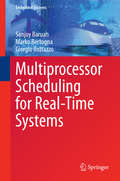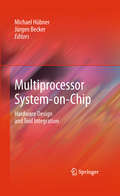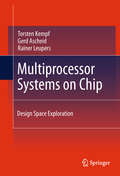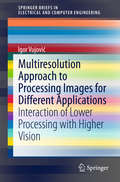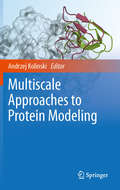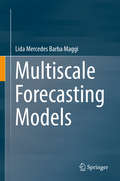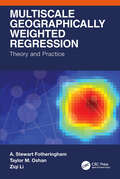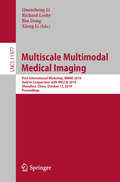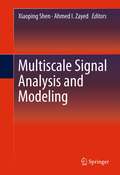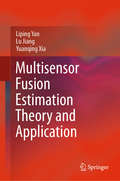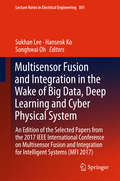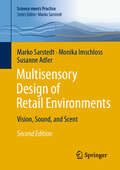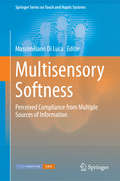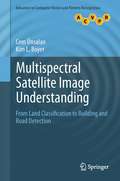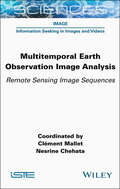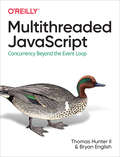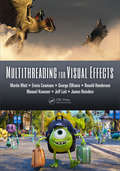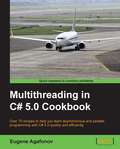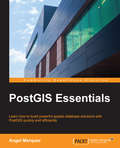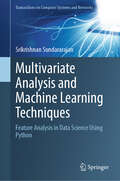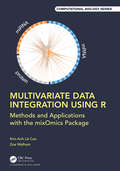- Table View
- List View
Multiprocessor Methods for Computer Graphics Rendering
by Scott WhitmanThis comprehensive work merges two of the hottest topics in computer science: parallel computing and computer graphics. Selected Topics from the Table of Contents: -Overview of Accelerated Rendering Techniques -Overview of Parallel Methods for Image Generation -Issues in Parallel Algorithm Development -Overview of Base Level Implementation -Compari
Multiprocessor Scheduling for Real-Time Systems
by Marko Bertogna Sanjoy Baruah Giorgio ButtazzoThis book provides a comprehensive overview of both theoretical and pragmatic aspects of resource-allocation and scheduling in multiprocessor and multicore hard-real-time systems. The authors derive new, abstract models of real-time tasks that capture accurately the salient features of real application systems that are to be implemented on multiprocessor platforms, and identify rules for mapping application systems onto the most appropriate models. New run-time multiprocessor scheduling algorithms are presented, which are demonstrably better than those currently used, both in terms of run-time efficiency and tractability of off-line analysis. Readers will benefit from a new design and analysis framework for multiprocessor real-time systems, which will translate into a significantly enhanced ability to provide formally verified, safety-critical real-time systems at a significantly lower cost.
Multiprocessor System-on-Chip
by Michael Hübner Jürgen BeckerThe purpose of this book is to evaluate strategies for future system design in multiprocessor system-on-chip (MPSoC) architectures. Both hardware design and integration of new development tools will be discussed. Novel trends in MPSoC design, combined with reconfigurable architectures are a main topic of concern. The main emphasis is on architectures, design-flow, tool-development, applications and system design.
Multiprocessor Systems on Chip
by Rainer Leupers Torsten Kempf Gerd AscheidThis book gives a comprehensive introduction to the design challenges of MPSoC platforms, focusing on early design space exploration. It defines an iterative methodology to increase the abstraction level so that evaluation of design decisions can be performed earlier in the design process. These techniques enable exploration on the system level before undertaking time- and cost-intensive development.
Multiresolution Approach to Processing Images for Different Applications
by Igor VujovićThis book presents theoretical and practical aspects of the interaction between low and high level image processing. Multiresolution analysis owes its popularity mostly to wavelets and is widely used in a variety of applications. Low level image processing is important for the performance of many high level applications. The book includes examples from different research fields, i. e. video surveillance; biomedical applications (EMG and X-ray); improved communication, namely teleoperation, telemedicine, animation, augmented/virtual reality and robot vision; monitoring of the condition of ship systems and image quality control.
Multiscale Approaches to Protein Modeling
by Andrzej KolinskiThe book gives a comprehensive review of the most advanced multiscale methods for protein structure prediction, computational studies of protein dynamics, folding mechanisms and macromolecular interactions. It approaches span a wide range of the levels of coarse-grained representations, various sampling techniques and variety of applications to biomedical and biophysical problems. This book is intended to be used as a reference book for those who are just beginning their adventure with biomacromolecular modeling but also as a valuable source of detailed information for those who are already experts in the field of biomacromolecular modeling and in related areas of computational biology or biophysics.
Multiscale Forecasting Models
by Lida Mercedes Barba MaggiThis book presents two new decomposition methods to decompose a time series in intrinsic components of low and high frequencies. The methods are based on Singular Value Decomposition (SVD) of a Hankel matrix (HSVD). The proposed decomposition is used to improve the accuracy of linear and nonlinear auto-regressive models. Linear Auto-regressive models (AR, ARMA and ARIMA) and Auto-regressive Neural Networks (ANNs) have been found insufficient because of the highly complicated nature of some time series. Hybrid models are a recent solution to deal with non-stationary processes which combine pre-processing techniques with conventional forecasters, some pre-processing techniques broadly implemented are Singular Spectrum Analysis (SSA) and Stationary Wavelet Transform (SWT). Although the flexibility of SSA and SWT allows their usage in a wide range of forecast problems, there is a lack of standard methods to select their parameters. The proposed decomposition HSVD and Multilevel SVD are described in detail through time series coming from the transport and fishery sectors. Further, for comparison purposes, it is evaluated the forecast accuracy reached by SSA and SWT, both jointly with AR-based models and ANNs.
Multiscale Geographically Weighted Regression: Theory and Practice
by A. Stewart Fotheringham Taylor M. Oshan Ziqi Li· Provides a balance between conceptual and technical introduction to local models · Explains state-of-the-art spatial analysis technique for multiscale regression modeling · Describes best practices and provides a detailed walkthrough of freely available software, through examples and comparisons with other common spatial data modeling techniques · Includes a detailed case study to demonstrate methods and software · Takes a new and exciting angle on local spatial modeling using MGWR, an innovation to the previous local modeling ‘bible’ GWR
Multiscale Modelling of Advanced Materials (Materials Horizons: From Nature to Nanomaterials)
by Balamati Choudhury Runa KumariThis volume covers the recent advances and research on the modeling and simulation of materials. The primary aim is to take the reader through the mathematical analysis to the theories of electricity and magnetism using multiscale modelling, covering a variety of numerical methods such as finite difference time domain (FDTD), finite element method (FEM) and method of moments. The book also introduces the multiscale Green’s function (GF) method for static and dynamic modelling and simulation results of modern advanced nanomaterials, particularly the two-dimensional (2D) materials. This book will be of interest to researchers and industry professionals working on advanced materials.
Multiscale Multimodal Medical Imaging: First International Workshop, MMMI 2019, Held in Conjunction with MICCAI 2019, Shenzhen, China, October 13, 2019, Proceedings (Lecture Notes in Computer Science #11977)
by Richard Leahy Xiang Li Quanzheng Li Bin DongThis book constitutes the refereed proceedings of the First International Workshop on Multiscale Multimodal Medical Imaging, MMMI 2019, held in conjunction with MICCAI 2019 in Shenzhen, China, in October 2019. The 13 papers presented were carefully reviewed and selected from 18 submissions. The MMMI workshop aims to advance the state of the art in multi-scale multi-modal medical imaging, including algorithm development, implementation of methodology, and experimental studies. The papers focus on medical image analysis and machine learning, especially on machine learning methods for data fusion and multi-score learning.
Multiscale Multimodal Medical Imaging: Third International Workshop, MMMI 2022, Held in Conjunction with MICCAI 2022, Singapore, September 22, 2022, Proceedings (Lecture Notes in Computer Science #13594)
by Xiang Li Quanzheng Li Bin Dong Richard M. Leahy Yuankai Huo Jinglei LvThis book constitutes the refereed proceedings of the Third International Workshop on Multiscale Multimodal Medical Imaging, MMMI 2022, held in conjunction with MICCAI 2022 in singapore, in September 2022.The 12 papers presented were carefully reviewed and selected from 18 submissions. The MMMI workshop aims to advance the state of the art in multi-scale multi-modal medical imaging, including algorithm development, implementation of methodology, and experimental studies. The papers focus on medical image analysis and machine learning, especially on machine learning methods for data fusion and multi-score learning.
Multiscale Signal Analysis and Modeling
by Ahmed I. Zayed Xiaoping ShenMultiscale Signal Analysis and Modeling presents recent advances in multiscale analysis and modeling using wavelets and other systems. This book also presents applications in digital signal processing using sampling theory and techniques from various function spaces, filter design, feature extraction and classification, signal and image representation/transmission, coding, nonparametric statistical signal processing, and statistical learning theory.
Multisensor Fusion Estimation Theory and Application
by Yuanqing Xia Lu Jiang Liping YanThis book focuses on the basic theory and methods of multisensor data fusion state estimation and its application. It consists of four parts with 12 chapters. In Part I, the basic framework and methods of multisensor optimal estimation and the basic concepts of Kalman filtering are briefly and systematically introduced. In Part II, the data fusion state estimation algorithms under networked environment are introduced. Part III consists of three chapters, in which the fusion estimation algorithms under event-triggered mechanisms are introduced. Part IV consists of two chapters, in which fusion estimation for systems with non-Gaussian but heavy-tailed noises are introduced. The book is primarily intended for researchers and engineers in the field of data fusion and state estimation. It also benefits for both graduate and undergraduate students who are interested in target tracking, navigation, networked control, etc.
Multisensor Fusion and Integration in the Wake of Big Data, Deep Learning and Cyber Physical System: An Edition of the Selected Papers from the 2017 IEEE International Conference on Multisensor Fusion and Integration for Intelligent Systems (MFI 2017) (Lecture Notes in Electrical Engineering #501)
by Sukhan Lee Hanseok Ko Songhwai OhThis book includes selected papers from the 13th IEEE International Conference on Multisensor Integration and Fusion for Intelligent Systems (MFI 2017) held in Daegu, Korea, November 16–22, 2017. It covers various topics, including sensor/actuator networks, distributed and cloud architectures, bio-inspired systems and evolutionary approaches, methods of cognitive sensor fusion, Bayesian approaches, fuzzy systems and neural networks, biomedical applications, autonomous land, sea and air vehicles, localization, tracking, SLAM, 3D perception, manipulation with multifinger hands, robotics, micro/nano systems, information fusion and sensors, and multimodal integration in HCI and HRI. The book is intended for robotics scientists, data and information fusion scientists, researchers and professionals at universities, research institutes and laboratories.
Multisensory Design of Retail Environments: Vision, Sound, and Scent (Science meets Practice)
by Marko Sarstedt Monika Imschloss Susanne AdlerOnline retailers have gained massive popularity in recent years, plunging large parts of brick-and-mortar retail into an existential crisis. In order to survive in times of growing online retail, brick-and-mortar retailers must become aware of their unique potential to address non-digitizable consumer needs and transform retail environments into places of experience and discovery. A key building block for achieving this aim lies in the creation of sensory experiences that motivate consumers to enter and linger in stationary retail environments. But how? To answer this question, this volume provides insights into the latest research results from sensory marketing on vision, sound, and scent. The authors describe the sometimes surprising effects of sensory cues on consumer behavior and provide clear recommendations for marketing practice. The second edition comes with an advanced coverage of various topics such as technology use in retail environments and includes new case studies.
Multisensory Softness
by Massimiliano Di LucaOffers a unique multidisciplinary overview of how humans interact with soft objects and how multiple sensory signals are used to perceive material properties, with an emphasis on object deformability. The authors describe a range of setups that have been employed to study and exploit sensory signals involved in interactions with compliant objects as well as techniques to simulate and modulate softness - including a psychophysical perspective of the field. Multisensory Softness focuses on the cognitive mechanisms underlying the use of multiple sources of information in softness perception. Divided into three sections, the first Perceptual Softness deals with the sensory components and computational requirements of softness perception, the second Sensorimotor Softness looks at the motor components of the interaction with soft objects and the final part Artificial Softness focuses on the identification of exploitable guidelines to help replicate softness in artificial environments.
Multispectral Satellite Image Understanding
by Kim L. Boyer Cem ÜnsalanThis book presents a comprehensive review of image processing methods, for the analysis of land use in residential areas. Combining a theoretical framework with highly practical applications, the book describes a system for the effective detection of single houses and streets in very high resolution. Topics and features: with a Foreword by Prof. Dr. Peter Reinartz of the German Aerospace Center; provides end-of-chapter summaries and review questions; presents a detailed review on remote sensing satellites; examines the multispectral information that can be obtained from satellite images, with a focus on vegetation and shadow-water indices; investigates methods for land-use classification, introducing precise graph theoretical measures over panchromatic images; addresses the problem of detecting residential regions; describes a house and street network-detection subsystem; concludes with a summary of the key ideas covered in the book.
Multistate Analysis of Life Histories with R
by Frans WillekensThis book provides an introduction to multistate event history analysis. It is an extension of survival analysis, in which a single terminal event (endpoint) is considered and the time-to-event is studied. Multistate models focus on life histories or trajectories, conceptualized as sequences of states and sequences of transitions between states. Life histories are modeled as realizations of continuous-time Markov processes. The model parameters, transition rates, are estimated from data on event counts and populations at risk, using the statistical theory of counting processes. The Comprehensive R Network Archive (CRAN) includes several packages for multistate modeling. This book is about Biograph. The package is designed to (a) enhance exploratory analysis of life histories and (b) make multistate modeling accessible. The package incorporates utilities that connect to several packages for multistate modeling, including survival, eha, Epi, mvna etm, mstate, msm, and TraMineR for sequence analysis. The book is a 'hands-on' presentation of Biograph and the packages listed. It is written from the perspective of the user. To help the user master the techniques and the software, a single data set is used to illustrate the methods and software. It is the subsample of the German Life History Survey, which was also used by Blossfeld and Rohwer in their popular textbook on event history modeling. Another data set, the Netherlands Family and Fertility Survey, is used to illustrate how Biograph can assist in answering questions on life paths of cohorts and individuals. The book is suitable as a textbook for graduate courses on event history analysis and introductory courses on competing risks and multistate models. It may also be used as a self-study book. The R code used in the book is available online. Frans Willekens is affiliated with the Max Planck Institute for Demographic Research (MPIDR) in Rostock, Germany. He is Emeritus Professor of Demography at the University of Groningen, a Honorary Fellow of the Netherlands Interdisciplinary Demographic Institute (NIDI) in the Hague, and a Research Associate of the International Institute for Applied Systems Analysis (IIASA), Laxenburg, Austria. He is a member of Royal Netherlands Academy of Arts and Sciences (KNAW). He has contributed to the modeling and simulation of life histories, mainly in the context of population forecasting.
Multitemporal Earth Observation Image Analysis: Remote Sensing Image Sequences (ISTE Invoiced)
by Clément Mallet Nesrine ChehataEarth observation has witnessed a unique paradigm change in the last decade with a diverse and ever-growing number of data sources. Among them, time series of remote sensing images has proven to be invaluable for numerous environmental and climate studies. Multitemporal Earth Observation Image Analysis provides illustrations of recent methodological advances in data processing and information extraction from imagery, with an emphasis on the temporal dimension uncovered either by recent satellite constellations (in particular the Sentinels from the European Copernicus programme) or archival aerial images available in national archives. The book shows how complementary data sources can be efficiently used, how spatial and temporal information can be leveraged for biophysical parameter estimation, classification of land surfaces and object tracking, as well as how standard machine learning and state-of-the-art deep learning solutions can solve complex problems with real-world applications.
Multithreaded Javascript: Concurrency Beyond the Event Loop
by Thomas Hunter II Bryan EnglishTraditionally, JavaScript has been a single-threaded language. Nearly all online forum posts, books, online documentation, and libraries refer to the language as single threaded. Thanks to recent advancements in the language--such as the Atomics and SharedArrayBuffers objects and Web Workers in the browser--JavaScript is now a multi-threaded language. These features will go down as being the biggest paradigm shift for the world's most popular programming language.Multithreaded JavaScript explores the various features that JavaScript runtimes have at their disposal for implementing multithreaded programming, providing both practical real-world examples, as well as reference material.Learn what multithreaded programming is and how you can benefit from itUnderstand the differences between a web worker, a service worker, and a worker threadKnow when and when not to use threads in an applicationOrchestrate communication between threads by leveraging the Atomics objectBuild high-performance applications using the knowledge you gain from this bookBenchmark performance to learn if you'll benefit from multithreading
Multithreading for Visual Effects
by James Reinders Martin Watt Erwin Coumans George ElKoura Ronald Henderson Manuel Kraemer Jeff LaitTackle the Challenges of Parallel Programming in the Visual Effects IndustryIn Multithreading for Visual Effects, developers from DreamWorks Animation, Pixar, Side Effects, Intel, and AMD share their successes and failures in the messy real-world application area of production software. They provide practical advice on multithreading techniques and
Multithreading in C# 5.0 Cookbook
by Eugene AgafonovCookbook.Multithreading in C# 5.0 Cookbook is written for existing C# developers who want a complete, professional, and authoritative guide to multithreading. You don't need any experience with multithreaded programming to use this book.
Multithreading with C# Cookbook - Second Edition
by Eugene AgafonovOver 70 recipes to get you writing powerful and efficient multithreaded, asynchronous, and parallel programs in C# 6.0 About This Book * Rewritten and updated to take advantage of the latest C# 6 features * Learn about multithreaded, asynchronous, and parallel programming through hands-on, code-first examples * Use these recipes to build fast, scalable, and reliable applications in C# Who This Book Is For This book is aimed at those who are new to multithreaded programming, and who are looking for a quick and easy way to get started. It is assumed that you have some experience in C# and .NET already, and you should also be familiar with basic computer science terminology and basic algorithms and data structures. What You Will Learn * Use C# 6.0 asynchronous language features * Work with raw threads, synchronize threads, and coordinate their work * Develop your own asynchronous API with Task Parallel Library * Work effectively with a thread pool * Scale up your server application with I/O threads * Parallelize your LINQ queries with PLINQ * Use common concurrent collections * Apply different parallel programming patterns * Use Reactive Extensions to run asynchronous operations and manage their options In Detail Multi-core processors are synonymous with computing speed and power in today's world, which is why multithreading has become a key concern for C# developers. Multithreaded code helps you create effective, scalable, and responsive applications. This is an easy-to-follow guide that will show you difficult programming problems in context. You will learn how to solve them with practical, hands-on, recipes. With these recipes, you'll be able to start creating your own scalable and reliable multithreaded applications. Starting from learning what a thread is, we guide you through the basics and then move on to more advanced concepts such as task parallel libraries, C# asynchronous functions, and much more. Rewritten to the latest C# specification, C# 6, and updated with new and modern recipes to help you make the most of the hardware you have available, this book will help you push the boundaries of what you thought possible in C#. Style and approach This is an easy-to-follow guide full of hands-on examples of real-world multithreading tasks. Each topic is explained and placed in context, and for the more inquisitive, there are also more in-depth details of the concepts used.
Multivariate Analysis and Machine Learning Techniques: Feature Analysis in Data Science Using Python (Transactions on Computer Systems and Networks)
by Srikrishnan SundararajanThis book offers a comprehensive first-level introduction to data analytics. The book covers multivariate analysis, AI / ML, and other computational techniques for solving data analytics problems using Python. The topics covered include (a) a working introduction to programming with Python for data analytics, (b) an overview of statistical techniques – probability and statistics, hypothesis testing, correlation and regression, factor analysis, classification (logistic regression, linear discriminant analysis, decision tree, support vector machines, and other methods), various clustering techniques, and survival analysis, (c) introduction to general computational techniques such as market basket analysis, and social network analysis, and (d) machine learning and deep learning. Many academic textbooks are available for teaching statistical applications using R, SAS, and SPSS. However, there is a dearth of textbooks that provide a comprehensiveintroduction to the emerging and powerful Python ecosystem, which is pervasive in data science and machine learning applications. The book offers a judicious mix of theory and practice, reinforced by over 100 tutorials coded in the Python programming language. The book provides worked-out examples that conceptualize real-world problems using data curated from public domain datasets. It is designed to benefit any data science aspirant, who has a basic (higher secondary school level) understanding of programming and statistics. The book may be used by analytics students for courses on statistics, multivariate analysis, machine learning, deep learning, data mining, and business analytics. It can be also used as a reference book by data analytics professionals.
Multivariate Data Integration Using R: Methods and Applications with the mixOmics Package (Chapman & Hall/CRC Computational Biology Series)
by Kim-Anh LeCao Zoe Marie WelhamLarge biological data, which are often noisy and high-dimensional, have become increasingly prevalent in biology and medicine. There is a real need for good training in statistics, from data exploration through to analysis and interpretation. This book provides an overview of statistical and dimension reduction methods for high-throughput biological data, with a specific focus on data integration. It starts with some biological background, key concepts underlying the multivariate methods, and then covers an array of methods implemented using the mixOmics package in R. Features: Provides a broad and accessible overview of methods for multi-omics data integration Covers a wide range of multivariate methods, each designed to answer specific biological questions Includes comprehensive visualisation techniques to aid in data interpretation Includes many worked examples and case studies using real data Includes reproducible R code for each multivariate method, using the mixOmics package The book is suitable for researchers from a wide range of scientific disciplines wishing to apply these methods to obtain new and deeper insights into biological mechanisms and biomedical problems. The suite of tools introduced in this book will enable students and scientists to work at the interface between, and provide critical collaborative expertise to, biologists, bioinformaticians, statisticians and clinicians.

